It should come as no surprise to most that the biblical writers were unfair to the gentler sex. After all, ever since Eve bit into the forbidden apple, the good book has been long obsessed with the notion of bad girls. Over the millennia, the stories of the Bible’s temptresses have been used by both religious disciplinarians and secular moralists alike to guide young women on how not to behave. This obsession with feminine transgression, turned the vices of these vixens into the stuff of legends—far surpassing their worst excesses. Spanning twelve centuries, the focus of this paper is on three bedeviling bad girls: Delilah, hailing from the Book of Judges in the Old Testament or Hebrew
Scriptures, followed a few centuries later by Jezebel from the Book of Kings, and ending with Salome’s story which appears in the first century of the common era in the New Testament.
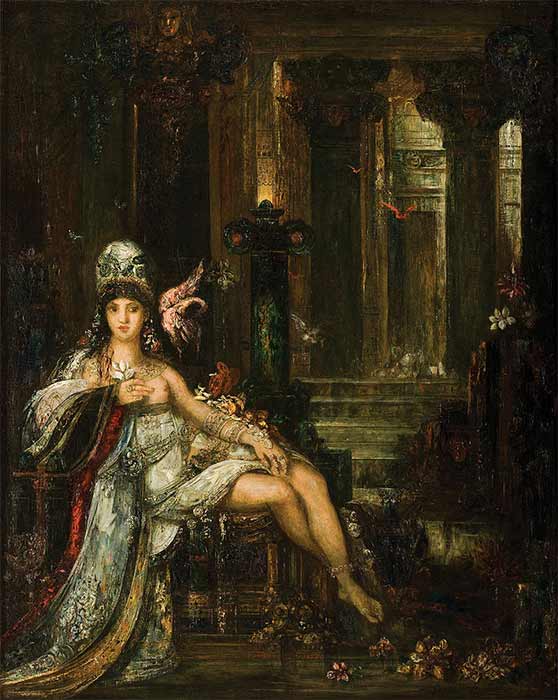
Leading off the journey is a woman about whom no one has anything good to say. To the Jews, not only was Delilah a Philistine but she is deceitful and a prostitute as well. Making a correlation between Samson and Christ, to the Christians she symbolizes the temptations offered by Satan himself and they compare her to Judas Iscariot. Time and again Delilah is cast as an unrepentant beguiler whose name is associated with seduction, treachery, but most of all betrayal. Because Delilah only appears in the 16th chapter in the Book of Judges to understand her motivations, it is important to get a glimpse into the background of her paramour, Samson.
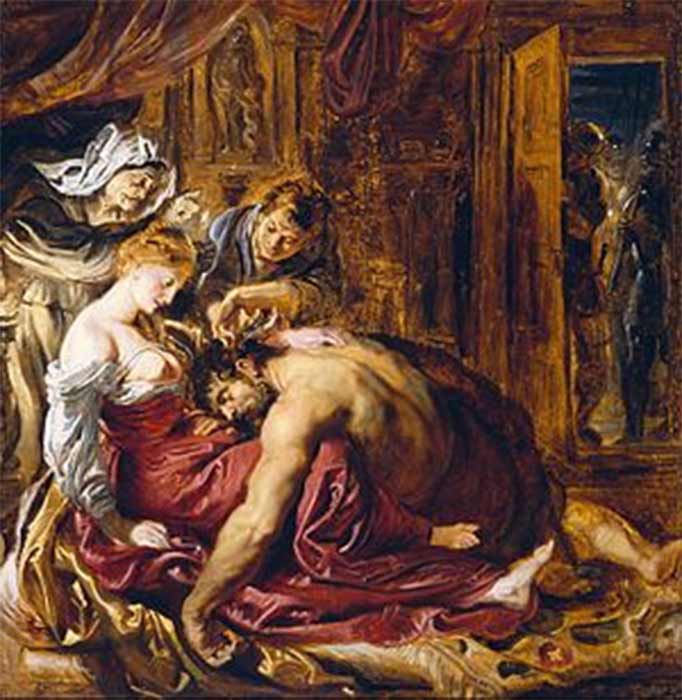
The fifteenth judge of Israel, Samson is believed to have lived during the years of 1154 to 1124 BCE during a time of repeated conflict between Israel and Philistia. Evidently, the aniconic one and only Israelite god, Yahweh, was disciplining the Israelites by putting them in the hands of the Philistines who were the region’s occupying power. Sworn in the womb to the service of Yahweh, Samson was a Nazarite who had taken a vow to Yahweh. Cutting his hair was one of several acts which were verboten. In return for this vow, Yahweh endowed Samson with superhuman strength for which Samson would become renowned.
Notorious for slaying one thousand Philistines with the jawbone of a donkey, Samson had a bloody past with the Philistines. But forasmuch as he despises Philistine men, he tends to favor their women—which leads to more conflicts with their men. Even his parents ask him: “Isn’t there an acceptable woman among your relatives or among all our people?” The moral of the parable seems to be not to marry or take up with a woman outside your own nation as time and again Samson’s liaisons with Philistine women get him into trouble. But no trouble is more severe than that which he finds with Delilah.

The Biblical narrator tells us that Samson falls in love with “a woman in the Valley of Sorek whose name was Delilah.” Sorek is a valley in ancient Philistia, though she is not identified as such, Delilah is understood to be a Philistine and notable in the tale as the only woman mentioned by name. Some assert that the fact she is mentioned by name may reflect that Delilah was a woman of independent means—yet her role in the story seems to belie this. When news of her relationship with Samson reaches the Philistine rulers, they ask her “to find the secret of his great strength,” promising her eleven hundred shekels—a significant sum of Philistine silver at the time. So begins the vicious game of cat and mouse with a wily Delilah pleading with an unwitting Samson to find the source of his great strength. Finally, Delilah plays her trump card: “How can you say I love you when you won’t confide in me?” The Biblical narrator tells us that with such nagging she prodded him day in and day out until he finally relinquished: “If my head were shaved my strength would leave me.”
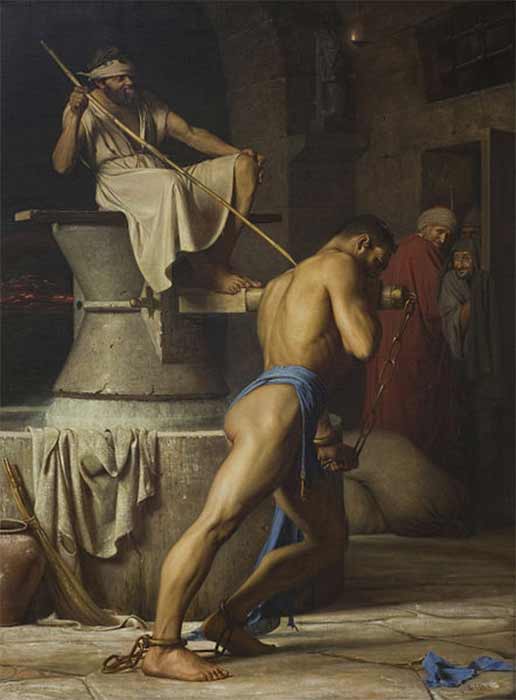
Immediately, she sent word to the Philistine rulers. “Come back once more”, she urged, “he has told me everything.” With the silver in their hands, they return. While sleeping the seven braids of his hair were shaved. He woke with a start but could not break free. Alas, the power of Yahweh had left him. Seizing him, the Philistines gouged out his eyes and took him down to Gaza where they bound him with bronze shackles and sent him to prison grinding grain. But then his hair began to grow. One day, the Philistines asked Samson to come out of prison to entertain them at one of their religious festivals. Coyly, Samson asked a servant if he could lean against the pillars that supported the temple. The temple was crowded with three thousand people—both men and women came out to watch Samson perform. Calling on Yahweh, Samson asked him for strength to get revenge on the Philistines “for my two eyes.” Declaring his intention to die with the Philistines, he tore the temple down, killing everyone in it, including himself. Some renditions of the tale say that Delilah was included in the temple destruction. In fact, the Biblical narrator tells us that the number of Philistines killed in the temple’s destruction transcends the total Samson had killed to date. And even though Samson himself dies in the process; Yahweh is satisfied with the outcome.
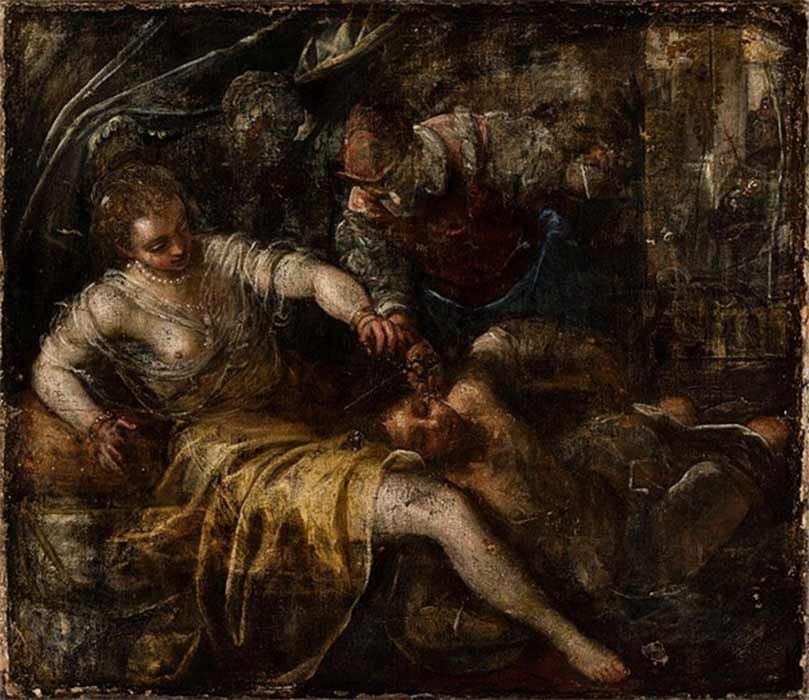
But what about Delilah’s role? Although she clearly has no allegiance to Samson, was she only in it for the money, or did she feel a kinship with the Philistines? Professor emeritus, John B. Vickery calls Delilah “a whore at heart.” In fact, by using her sexuality as a commodity, there is little difference between Delilah and a prostitute. But was money her sole motivation? Aside from what the biblical narrator

asserts, a possible subtext is that Samson, known for his violence against others, used his savagery against Delilah as well. Could subduing his violence against her be the reason Delilah sheared Samson’s locks? If so, her reasons for weakening him were personal, not financial.
Some merely see Delilah as the archetype of how a “bad woman” can lead to the downfall of a “good man.” One thing is certain, although Delilah’s role as a trickster is hardly commendable, she exists outside patriarchal boundaries and was cunning and guileful enough to get the better of the strongest and most brutal of men. But if the moral of Samson and Delilah’s story is never to be involved with a woman from another nation this appears to be doubly so for our next Biblical bad girl.
In stories passed down through the ages, Jezebel has come to epitomize wicked womanhood. In fact, her notoriety remains so great that her name turned noun is synonymous with shameless, morally unrestrained female promiscuity. In a search of synonyms for the word “jezebel,” hussy, strumpet, and trollop are just a few that appear in her honor. But was this seventh queen of the Northern Kingdom of Israel a woman of loose virtue as these names would seem to indicate? If Delilah’s claim to fame was shearing Samson’s locks, what exactly was Jezebel’s?
According to the sixteenth chapter of the Book of Kings, Jezebel was the daughter of the priest-king Ethbaal, ruler of the Phoenician coastal cities of Tyre and Sidon (Lebanon). She married King Ahab of Samaria who ruled from 871- 852 BCE from the Northern Kingdom of Israel. In fact, it is believed that Psalm 45 was written about their wedding ceremony. “And the daughter of Tyre shall be there with a gift.” The marriage was the byproduct of friendly relations between the Northern Kingdom of Israel and Phoenicia. Everything seemed to portend well but straightaway the biblical narrator in I Kings implies that the union between Ahab and Jezebel is the embodiment of sin: “he took a wife Jezebel….and served Baal and worshipped him.” In an endless fight against idolatrous polytheism, Baal was the storm god and god of fertility in the ancient Near East and as such was often seen to be adversarial to the one and only monotheistic Israelite god, Yahweh.

Like the foreign wives of Solomon, Jezebel required provisions for carrying on her faith so under her influence, temples and altars were built dedicated to Baal and to the mother goddess Asherah often paired with Baal and represented by a wooden pole. Moreover, 450 priests of Baal and 400 priestesses of Asherah were relocated into the royal household. The chief concern of the biblical narrator is that Baal will replace Yahweh as the national god of Israel. In fact, because he was a familiar fertility god of the region, Baal was sometimes celebrated alongside Yahweh to the great consternation of the prophet, Elijah who accuses the Israelites of equivocation between the two gods.
When Elijah hosted a contest between Baal and Yahweh to see which of the two gods would ignite a bull offering, predictably Baal lost the contest. As a result, Elijah massacred all of Baal’s prophets. When Jezebel got word of the senseless slaughter she sent a messenger to Elijah “….this time tomorrow your life will be like one of Baal’s prophets.” Some scholars assert that if Jezebel wanted Elijah killed, she would have sent an assassin to dispatch him, not a messenger to warn him. Jezebel, they say, preferred a “live” Elijah in exile, rather than a dead Elijah worshipped as a martyr. Repeatedly the biblical narrator laments about Jezebel: “But there is none like unto Ahab, which did sell himself to work wickedness…. whom Jezebel his wife stirred up.” Regardless of historical accuracy, Jezebel is portrayed as the reckless and power-hungry female subduing a spellbound and enfeebled husband.

After Ahab died in battle, his throne passed to his eldest son, Ahaziah, whose reign was destined to be short-lived. The biblical narrator criticizes Ahaziah for following the ways of his mother—biblical scholar, Albert Barnes, notes that the phrase “in the ways of his mother” does not occur anywhere else in the Hebrew Bible and demonstrates Jezebel’s strong influence. Jezebel’s second son, Jehoram succeeded his brother reigning for ten years. Although Jehoram did not worship Baal and had destroyed Baal’s temples the biblical narrator casts blame at him and at the supposed transgressions of the queen mother. Indeed, the only time we hear of Jezebel referred to as mother in the Bible the word “whoredom” is used in the same sentence: “so long as the whoredoms of thy mother, Jezebel are so many.” After Jehoram was deposed by his army commander, Jehu, to complete the full dethronement it was necessary to dispatch the queen mother. To prepare for her encounter with Jehu, Jezebel painted her face. “When Jehu was come … she painted her eyes and adorned her head and looked out a window.” Through the ages, much has been made of her applying makeup before her execution. Was she trying to seduce her son’s killer as the biblical narrator would have us believe? Far from flirtatious, her defiance is evident when she addresses her son’s killer mockingly as Zimri, the name of the previous usurper of the Israelite throne: “Is it peace Zimri, murderer of your master?” Referring to Jehu as Zimri was an insult to the new king because Zimri’s reign was notoriously short-lived—lasting a full seven days before he himself was overthrown. In the face of certain death, Jezebel mocked her executioner by predicting his reign would be a short one.

Prior to her death, Jezebel stood at the window awaiting her fate. Usually associated with royalty, in the ancient Near East, the woman-at-the-window motif is also indicative of the Hebrew goddess Asherah, for whom Jezebel was a devotee. Biblical scholar, Susan Ackerman asserts that as the earthly counterpart to Asherah, queen mothers wielded considerable power in Israel. Highlighting her importance, three eunuchs stood behind Jezebel at the window assisting with the transfer of power. Though they too transgressed gender roles—the eunuchs ultimately betray her and comply when Jehu cries, “Throw her down!” The act of being thrown out a window is called defenestration and symbolizes a fall from power. Biblical scholar Judith E. McKinlay asserts that the biblical narrator demonstrates that because Jezebel did not act her part as a woman in Israel “she must fall from her place.” After Jezebel was hurled to her death, Jehu said,
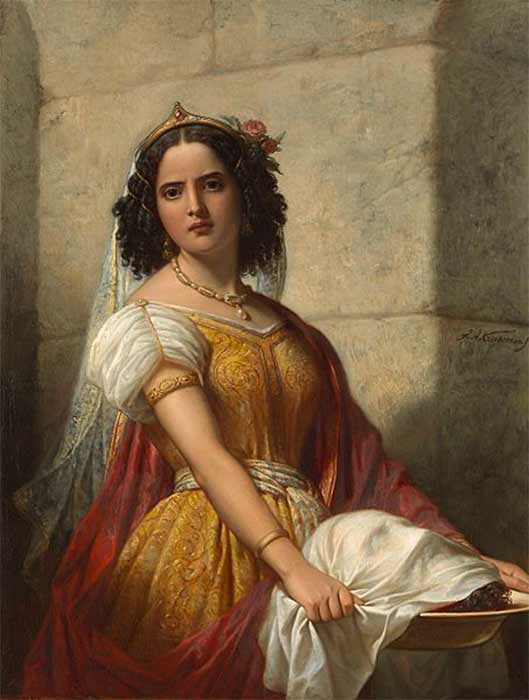
“See now to this cursed woman and bury her, for she is a king’s daughter.” Yet she was not buried. Legend has it that while Jehu was enjoying his repast, Jezebel’s body was devoured by wild dogs. Daughter of a king, wife of a king, and mother of two kings, although she is never referred to as queen in the biblical record, the fact is that Jezebel reigned for over thirty years as a forceful and unwavering monarch. The degree to which Jezebel is tenaciously derided by the biblical narrator matches in proportion to the degree to which she wielded power.
Nearly a millennia later, the story which launched a thousand legends is a short one and the seductive siren, Salome—thought to be anywhere from a mere ten to sixteen years of age—is not even mentioned by name. Although an essential player to the plot she is only referred to as “girl” or “daughter of Herodias”—only later is she identified as “Salome” by the Jewish historian, Flavius Josephus. Moreover, the antecedent action which precedes her story is as salacious as the story itself. It was love at first sight when Herod locked eyes with his niece and sister-in-law Herodias. He was so overcome with passion that he proposed to her on the spot –even though each of them was married to others. The divorces and subsequent marriage of Herod and Herodias did not sit well with the popular John the Baptist who was famous for baptizing his followers in the Sea of Galilee. Hailing from a sect called the Essenes which preached abstinence from physical pleasure, John believed that sex should only be practiced for procreational purposes. Unsurprisingly, he railed against the union of Herod and Herodias as an incestuous one: “It is against the law for you to marry your brother’s wife.” For his impertinence, Herod imprisoned John the Baptist but restrained himself from killing the prophet as his new wife preferred. The truth is, John’s popularity greatly exceeded Herod’s, so according to Josephus, the ruler justifiably feared an uprising if he did anything rash to the preacher.
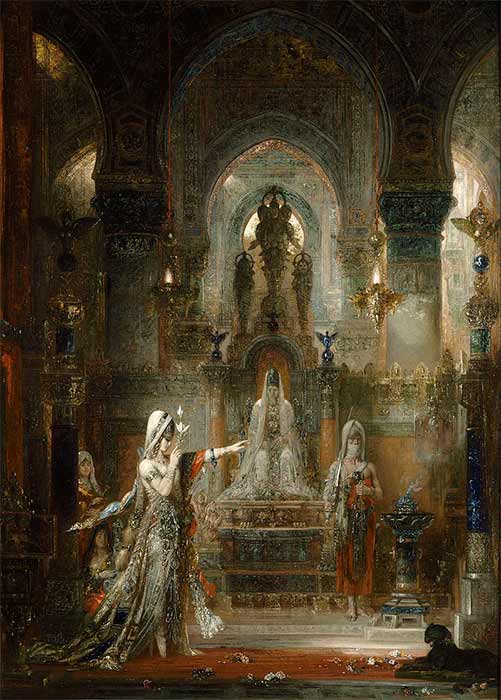
The story according to the gospels of Mark and Mathew begins when Herod throws a birthday party for himself inviting only the most powerful of men. The main event of the festive gathering was a dance performed alluringly by his stepdaughter, a nubile Salome. Alas, the legendary dance of the seven veils is an invention of the 19th-century playwright Oscar Wilde in his one-act play “Salome.” According to the biblical narrators, Salome’s movements were so bewitching that the ruler invited his stepdaughter to ask him for anything she wanted adding the oath: “Whatever you ask I will give you, up to half my kingdom.” In truth, because Herod was no king, he was unable to give Salome half his kingdom even if he wanted. As mere tetrarch—which literally means ruler of the fourth part—he was answerable to his Roman overlords who would not likely have granted him permission to relinquish half of Galilee to a young girl.
Uncertain for what she should ask, the gullible Salome turned to her mother for advice. A shadowy figure with a savage voice, Herodias urged her daughter to answer: “Give me on a platter the head of John the Baptist.” Just like that her mother’s wish was Salome’s command: “I will that thou will give me by and by in a charger the head of John the Baptist.” Herod was flabbergasted. He had expected something easy enough to appease the whims of a pubescent. Yet because he swore an oath in front of his influential guests, he could not renege on the offer. According to both Matthew and Mark, the ruler was sorry to order the execution. But as aggrieved as Herod may have been, he did not waiver, and in no time the freshly severed head of John the Baptist was served to the girl on a platter—who in turn carried it to her exacting mother.

Though both the gospels and Josephus’s histories were contemporaneous Josephus never mentions John’s beheading. Some believe that this could be because beheading was a common form of execution in the Roman Empire so Josephus may not have considered beheading to be noteworthy. Further, in Josephus’s accounts, there is no alluring dance. In fact, some believe that the dance narrative is more fiction than fact arising from Herod’s deep unpopularity in the region. Only courtesans would dance at such a festive gathering, experts contend. Biblical historian Harold Hoehner asserts: “the presence of a respectable woman, particularly a daughter of a noble family, at an ancient stag dinner is quite unlikely.” If Salome’s appearance is unlikely at such an event, her dancing seductively at a stag party is unlikelier still. On the other hand, Herod was known to violate improprieties as his unconventional marriage to his sister-in-law demonstrates. If upon first sight he could ask for the hand of his sister-in-law, he is a man of inappropriate carnal desires who may have seen no harm in his stepdaughter’s seductive dance.
In this cautionary tale about the power of female savagery, the real villain is Herodias. But why would Herodias want the death of John the Baptist? Some posit that Herodias may have feared the charismatic preacher’s influence on her new husband. After all, if it were easy enough for Herod to take Herodias as his wife, it was just as easy for him to cast her aside as the preacher favored. Scarcely seen, Herodias is mightily heard whereas the conspicuous Salome is voiceless in the story—a mere appendage of her mother’s fierce will. Yet the mother-daughter duo act in concert with each other luring unwitting males to their inevitable doom.
Perhaps fate might have been kinder to Herod if he’d listened to the ramblings of the itinerant preacher after all. Indeed, the divorce from his first wife proved unwise as she was the daughter of a neighboring king setting off a border war for which Herod’s army was roundly defeated. Shortly thereafter he was deposed by his nephew and the hapless couple was exiled to Spain—never to be heard from again.

But what became of Salome? Keeping steadfast to the family tradition of inbreeding, her first husband, Phillip, Tetrarch of Trachonitis, was also her uncle. After his death, she married her first cousin, Aristobulus who would go on to become king of Chalcis, making Salome queen. They had three sons.
Ranging in dates from the deep antiquity of the Old Testament to the beginning of the common era in the New Testament, the stories weaved about these women can all be reduced to a single component: their sinful seductiveness. If not for the substantial charms of Delilah, Samson might have lived to see old age, Queen Jezebel was reduced to harlotry because she had the temerity to be a strong female leader. And finally, but for the siren Salome and her wicked mother, John the Baptist might have kept his head. Regardless of female transgressions, the wickedness of the one-dimensional temptress is played over again throughout. In looking back over the span of epochs things have improved substantially for women, yet in some ways, they have stayed much the same.
